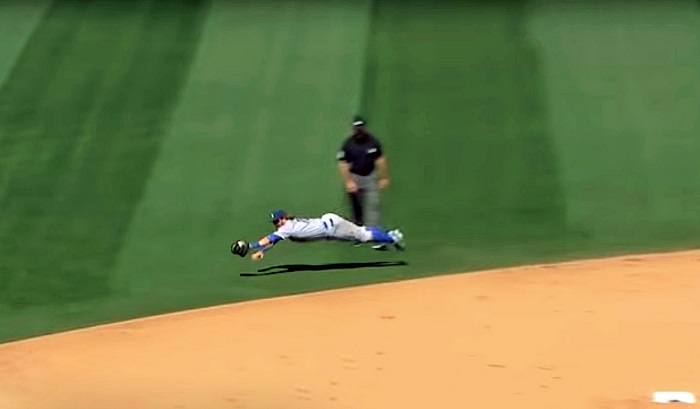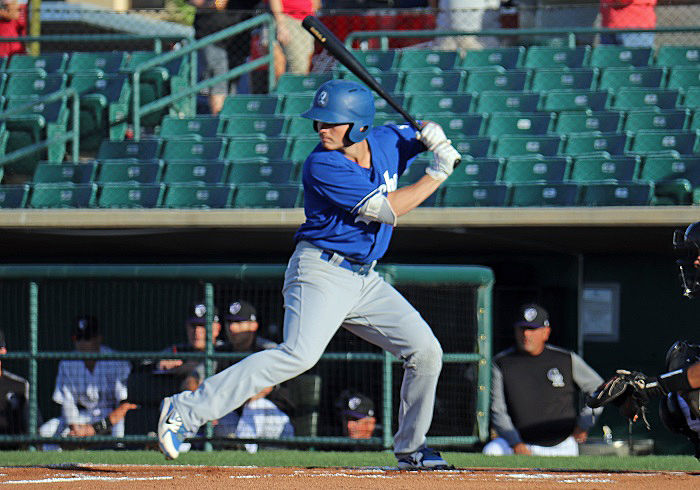One of the hot topics among Dodger fans this off-season has been: Who will be their team’s so-called everyday second baseman in 2019? – So-called because, as we all know, Dodgers president of baseball operations Andrew Friedman’s unwavering analytics-driven method of doing things has pretty much made the term ‘everyday’ obsolete.
Oh sure, there are a few guys who will be out there for upwards of 150-ish games this season, but the likelihood of them remaining in games for all nine innings lies somewhere between slim and none; or at least slim and slimmer.
With it becoming increasingly apparent that the Dodgers have no intention of bringing back shortstop Manny Machado, and with Dodgers All-Star shortstop and 2016 National League Rookie of the Year Corey Seager expected to return as their ‘everyday’ shortstop after missing most of the 2018 season due to two surgeries, all eyes are on 2B.
Although there is no reason to believe that 35-year-old veteran third baseman David Freese won’t – or at least couldn’t – see some playing time at second base, of his 914 career games over 10 MLB seasons, he has played the position exactly twice, both with the Pittsburgh Pirates back in 2016.
And then, of course, there has been considerable chatter on social media that 34-year-old fan-favorite Dodgers third baseman Justin Turner might also be an option at second base for Dodgers manager Dave Roberts, but here again, of JT’s 598 career games over his 10 MLB seasons, he has played the position 213 times, but not since 2015.

In other words, the Dodgers still need a bona fide second baseman.
…or do they?
Although the Dodgers recently acquired (very) highly touted middle infield prospect Jeter Downs (along with veteran left-hander Homer Bailey and minor league right-hander Josiah Gray) from the Cincinnati Reds in the trade that sent popular Dodgers outfielders Yasiel Puig and Matt Kemp, and utility infielder/catcher Kyle Farmer to The Queen City, Downs is only 20 years old.
Additionally, the San Andres, Colombia native’s highest level of play thus far has been at the Low Single-A level; not to mention the fact that he has appeared in a grand total of 170 games over his two-years in professional baseball. Simply put and regardless of how highly ranked and touted he is as a prospect, he will, in all likelihood, begin the 2019 season with the Dodgers Advanced Single-A Rancho Cucamonga Quakes.
So what now? Who’s left?
The answer is so blatantly obvious that if he were a snake, he would bite you in the … hand – 21-year-old Gavin Lux, whom the Dodgers selected in the first round (20th overall pick) of the 2016 MLB First-Year Player Draft out of Indian Trail High School in Kenosha, Wisconsin.

Or sure, you can certainly argue that there isn’t much difference between a 20-year-old and a 21-year-old, but unlike Downs, Lux appeared in 88 games at Advanced Single-A Rancho Cucamonga and 28 games with the Dodgers Double-A affiliate Tulsa Drillers this past season. Additionally, the Dodgers think highly enough of their former first-rounder that when initial trade talks began with the Baltimore Orioles to bring Machado to Los Angeles, the Dodgers absolutely refused to include Lux in that or any other trade talks, and understandably so.
With the Quakes and Drillers in 2018, the 6′-2″ / 190-pound middle infielder posted a combined slash-line of .324 / .399 / .514 for an insane .913 OPS. He also slugged a combined 27 doubles, eight triple and 15 home runs, while driving in 57. For good measure, he also swiped 13 bags.
Where things get a little bit ‘iffy’ with Gavin Lux is that of his 118 combined games during the 2018 season, he played 92 games at short and only 17 at second base, and all of those at Rancho Cucamonga. That being said, during those 17 games, he committed only four errors in 85 total chances for an excellent .953 fielding percentage.
Realistically, it’s probably a bit of a reach to think that Lux will be the Dodgers Opening Day (or ‘everyday’) second baseman on March 28. However, unless Andrew Friedman finds a proverbial diamond in the rough second baseman between now and then, it’s hard to believe that Lux won’t get an extremely close look at second base during major league spring training camp … to which he has already been invited.
Play Ball!
* * * * *




 January 22nd, 2019 at 8:00 am
January 22nd, 2019 at 8:00 am  by Ron Cervenka
by Ron Cervenka  Posted in
Posted in 

I love the Dodgers depth at 2b, Lux being at the top of the list. I saw him a couple of days last spring on the back fields — what a huge difference from the 2017 spring training. Downs seems like a terrific prospect, but not far behind are Amaya, Arocho, Liput, Mann, and Zach McAllister has been solid so far. One guy who is flying under the radar for a utility 2b role is Matt Beaty. Lot of young prospects in the lower levels who we will be discussing this year.
Perhaps, just maybe, Friedman isn’t active in the offseason because of exactly this: the farm system. The farm not here just to develop currency to pay for some trade. Maybe Friedman is like me, who would prefer to see an all-homegrown team. Also, going with (cough) cheap (cough) cost-controlled players is perfect for a team bouncing off the tax threshold.
No doubt that Dodgers would prefer to fill its needs internally. If Will Smith or Keibert Ruiz were ready today then the Dodgers would not have traded for Martin and the Realmuto rumors would be attached to other teams. If Verdugo was a RH hitter and/or DJ Peters was ready for the majors then there would be no chatter about signing Pollock, or trading for Marte.
Yeah, Friedman like you, would prefer to see an all-homegrown team.
Friedman’s reason though is all about money, as it should be. Developing homegrown talent through the MLB draft is probably the cheapest way to field a MLB team.
In 2018 the Dodgers draft bonus pool was approximately $5.3M to sign their top 10 draft picks. After drafting a player the team gets 4-5 years of minor league control then 6 years of control at the major league level (or close to those amounts). What a bargain way to field a team.
I asked a few threads ago, what do people think the 31st pick in this years draft is worth. I asked because, we will forfeit it if we sign Pollock, which is why I don’t believe we will sign him before June 3, if at all.
The draft bonus pool amount allocated to the 31st pick in the 2018 draft was $2,224,000. Which means that is the recommended signing amount for that draft pick. But what’s it worth in dollars? I think perhaps ten times that amount or approximately $20M. A huge penalty to pay for signing a Harper or Pollock. Oh course in Harper’s case a much smaller percentage of the whole cost to sign him.
Taking Gavin Lux as an example, he was drafted 20th and signed for $2.3M. He looks to be a potential stud with six years of MLB control ahead of him. What a value today, probably worth much more than $23M. Dustin May same story.
Top notch post. Recently the 2014, 31st pick, Justus Sheffield was traded by the Yankees to the Mariners for James Paxton. And before that, Sheffield (who at the time was the Indians’ top prospect) was the key player going to the Yankees for Andrew Miller. Based on Fangraphs value per WAR, just over $8MM, a 2 WAR player is worth over $16MM per season.
Great example.
Yeah, some statistic like WAR has got to be figured when valuing these guys.
Looking at Realmuto, produced 4.9 WAR in 2018, 4.9 x 2 (yrs of control) x $8M (WAR value) = $78.4M – $12M (Estimated salary next two yrs) = $66.4M estimated excess value.
I guess I can see why Miami is asking for the moon or why Mitch Haniger’s contract is maybe the most valuable in baseball.
Until a better method comes forth, WAR seems like a reasonable measuring stick as we can compare player to player with the same measuring criteria. I don’t know how Fangraphs calculates the $8+MM amount per WAR, but again it is a consistent method of valuing players. A reason why Joc Pederson is of interest to other teams, a 2019 salary of $5MM with a 2018, 2.7 WAR (Fangraphs) being equivalent to $21.9MM, and over his Dodgers career $80.7MM.
Wow, Dodgers really hit a home run with the former 11th round draft pick. And with his two years of remaining control, he should bring something back really nice if traded.
Top notch post indeed.
Although it remains to be seen, especially with Lux, May, and even Verdugo, this has been my thought all along (that Friedman is waiting / banking on his own homegrown players to develop). If Friedman makes it through this Hot Stove season without trading them (especially Lux), I will have an entirely new respect for him.
Fingers crossed.